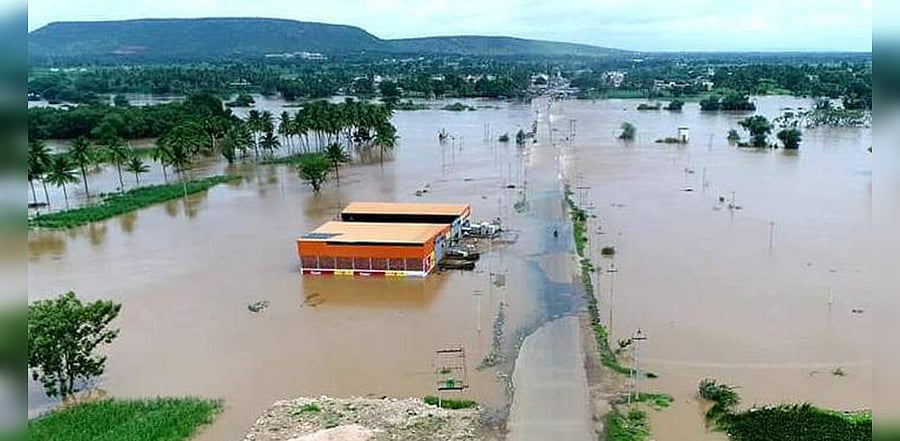
In recent years, extreme rainfall events leading to flooding are becoming common, particularly in the Western Ghats and northern districts of Karnataka. This year is no exception, with July and August rainfall events leading to damage to life, crops, infrastructure and property. Large-scale flooding has occurred three years in a row. The first question is, if the excessive rainfall and high intensity (mm of rainfall in 24 hours) events are a result of ongoing climate change.
There is enough scientific evidence to show that without the increased CO2 or greenhouse concentrations, the observed extent of extreme rainfall events would not have occurred. World Meteorological Organization, in its report ‘The Global Climate in 2015–2019,’ concluded, “While tropical cyclones are responsible for many of the world’s most destructive floods, there have been many other instances of major flooding since 2015. Some of these floods have been relatively long-lived responses to excessive rainfall in tropical regions during the monsoon season, but others have been shorter-term floods, including flash floods associated with intense rainfall over a few hours. Heavy rains have also contributed to major landslides in some parts of the world”. There are other studies to support that climate change is driving the observed recent trends of extreme rainfall events with high intensity, pounding the Malnad, coastal and northern districts of Karnataka and many parts of India and the world, leading to unprecedented flooding, damage and loss.
The damage or loss due to extreme rainfall depends on quantity of rainfall and its intensity, land topography, vegetation cover, particularly in the catchment areas, extent of land conversion or use for buildings, roads, industries, etc. There is a general understanding that land degradation, forest degradation and increased settlement and infrastructure development have all exacerbated the effect of extreme rainfall leading to damage and loss of life, property and infrastructure.
In the context of droughts and floods, floods are always more damaging. Droughts lead to decline in crop yields or water shortage. While according to Karnataka State Natural Disaster Management Centre, for example, the 2019 floods led to crop damage in 10 lakh hectares with a crop loss of Rs 15,000 crores, 2.47 lakh homes damaged and 28,000 km road damaged in Karnataka. In addition, damages include landslides, soil erosion, silting of reservoirs and spread of water-borne diseases. Till recently, in Karnataka, all the focus used to be on drought and government seeking drought relief from central government, loan waivers to farmers, promise of investment in irrigation and crop insurance. Damage due to flood events received much less attention than droughts.
The second question facing the people and policymakers is what will be the impact of climate change on rainfall pattern, extreme rainfall events and flooding in the coming years and decades. Recent report of Ministry of Earth Sciences concluded, “With continued global warming, climate models project an increase in the annual and summer monsoon mean rainfall, as well as the frequency of heavy rain occurrences over most parts of India during the 21st century. The interannual variability of summer monsoon rainfall is also projected to increase through the 21st century”. Multiple CORDEX (Regional climate modelling program) models based assessment made by Indian Institute of Science has shown, for example, in the taluks of Dakshina Kannada, Udupi and Kodagu, June to September rainfall is projected to increase in the range of 13% to 25% (under moderate and most likely scenarios of climate change, respectively) compared to long-term average rainfall by 2030s. Further, the number of high-intensity rainfall events are projected to increase in the range of 1 to 2 additional events annually of 50 to 100 mm per day and more than 100 mm per day rainfall intensity. The increase in June to September total rainfall and the occurrence of high rainfall events is projected for the majority of taluks and districts of the Western Ghats and Northern Karnataka, even by 2030s.
Climate models show that in the coming years and decades, the June to September total rainfall and number of high-intensity rainfall events will rise in most districts. Such model-based studies provide opportunity to prepare in advance, for early warning systems, to build resilience to flood risks, to incorporate climate change projections in planning infrastructure and development programmes and to build capacity in the administration.
However, in India and in Karnataka, the reality with respect to disasters such as droughts and floods, which can reasonably be predicted in advance, is largely on post-disaster response than advance preparedness. This is because of a number of reasons; the Deputy Commissioners at district level who are responsible for preparing and implementing the District Disaster Management Plans are over burdened with routine administrative and law and order responsibilities, have limited technical capacity and staff at the district level, with very limited or no funding for advance disaster mitigation and resilience measures. The National Disaster Management Plan (NDMP) of 2019, prepared by NDMA is based on outdated climate change science and model projections. NDMP does not give any guidelines on how to consider or incorporate the latest climate modelling science and projections in to District Disaster Management Plans.
However, there are obvious win-win strategies for adaptation to flood disasters in the coming years and decades, especially driven by climate change; preventing forest degradation and loss, revegetation of catchment areas, improved access to early warning systems, incorporating climate change impact and resilience component in all infrastructure programs, avoiding settlement or infrastructure expansion in flood-prone locations, construction of flood protection barriers, etc. There is no shortage of policies and measures required for building resilience to climate risks. Unfortunately, advance preparation will remain a dream, and vulnerable communities would be lucky if they at least get some relief and rehabilitation assistance, post-flood. During 2020 floods, due to Covid-19 crisis, there is little chance of getting any relief from the government.
(The writer is a former Professor, Indian Institute of Science)